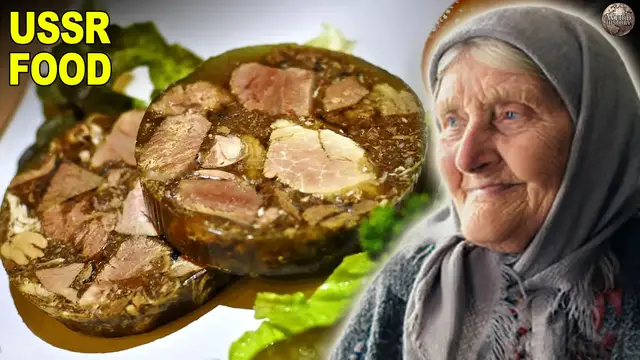We've all drank, and we've all had our own personal booze filled disasters, but, did you know that in history, two major 'booze disasters' eclipse them all? Take a mental stroll with us through history, and examine with us the great beer flood that happened in London, and the time the most unthinkable happened: That crazy fateful day that Russia ran out of Vodka!
Show More Show Less View Video Transcript
0:00
After World War II, Soviet Russia and the whole of the Soviet Union found itself under the
0:07
authoritarian rule of Joseph Stalin. As the Cold War progressed, leaders such as Nikita Khrushchev
0:13
and Mikhail Gorbachev brought changes to the communist stronghold, but finding enough to eat
0:18
remained a problem for millions. To survive, people had to get innovative in the kitchen
0:24
This often meant resorting to unconventional foods that reflected the multiculturalism of
0:28
the Soviet Union, or just making do with whatever happened to be available. Today, we're going to
0:33
take a look at some unconventional foods people ate to survive in Soviet Russia. Okay, so let's
0:39
find out what they ate back in the U.S., back in the U.S., back in the USSR
0:48
Shirniki, or cheese pancakes, were made from tvorak, or dry curd cheese, and they were a staple
0:54
for breakfast in the Soviet Union. Often cooks added fresh or dried fruit to the pancake
0:59
or included some compote. Once a mixture of cheese, eggs, flour, and other items to taste was ready
1:05
it was poured into a buttered skillet and cooked until brown on one side
1:09
It was then flipped and browned on the other. Shiriniki could then be served with more fruit
1:13
or with sour cream. The term katliette once referred to cutlets of meat
1:21
but over time, the dish evolved. By the Soviet era, the term came to refer to a meal that fell somewhere between a meatball and a hamburger
1:29
Katliette typically includes minced meat mixed with vegetables like cabbage, carrots, and beets
1:34
This mixture may or may not be breaded, but is always fried
1:42
Thought to have been invented during the 1800s, chicken Kiev has long been considered a delicacy, even during the Soviet period
1:49
The dish featured chicken fillets with a bone sticking out of the side
1:53
The meat was filled with a butter of sorts and came to be served at restaurants throughout major cities in Russia
1:59
It later found global attention, especially popular among tourists as they were introduced to Russian cuisine at tourist restaurants
2:06
which were sponsored by the official tourist agency of the Soviet Union. The dish, however, is not without its controversy
2:12
Both Russians and Ukrainians claim ownership of Chicken Kiev, something that found new attention when George H.W. Bush gave his so-called
2:20
Chicken Kiev speech in 1991. The talk was written by future Secretary of State Condoleezza Rice
2:25
and delivered from Kiev, which was part of the Soviet Union at the time. Long story short, it seemed to indicate Bush and the United States did not support Ukrainian
2:35
independence as the breakup of the Soviet Union loomed, a position that wasn't terribly popular
2:40
with Ukrainians or Bush's conservative allies back in America. Perhaps the most identifiable Russian meal, borscht
2:52
was generally made up of broth, beets, and cabbage, with countless other additives
2:57
These included but were not limited to things like potatoes beans eggs vegetables and cream The dish was then served chilled or piping hot depending on the season and preference of whoever was eating it
3:09
Borscht also took on regional differences. In some regions, like Romania, fruit was often added
3:15
and seasonal availability of foods also dictated what was thrown into the mix
3:19
As a meal consumed by poor Russians long before the rise of the Soviet Union
3:23
Borscht was touted as a healthy, relatively easy, and delicious meal by military men
3:28
Soviet premiers, and cosmonauts alike. Borscht even appears in historical events, like the mutiny on the battleship Potemkin, and in literary works like The Master and Margarita
3:39
by Mikhail Bulgakov. During the Cold War, recipes for Borscht remained well guarded
3:45
After all, one can't have their recipes for dinner falling into enemy hands
3:49
When it was finally released by the CIA, a traditional borscht recipe from 1948 revealed how beets, fat, bouillon, tomato paste, and vinegar were combined in a closed pot before adding flour, laurel leaves, and seasoning
4:04
With cabbage and potatoes incorporated into the mix, borscht was served after subsequent stewing
4:09
It could also include sauerkraut, beet leaves, and millet. It really just depended on what a cook had on hand
4:20
Drawing from both the French vinaigrette tradition and the Russian practice of finely chopping
4:25
vegetables, vinaigrette was a term applied to, well, just that, vegetables chopped up and covered
4:30
in an oil-based dressing. Some featured meat, but during the Soviet era, it was more common to have
4:36
cabbage, beets, and pickles covered in sunflower oil. To make them soft and tender, the vegetable
4:41
ingredients were boiled prior to being chopped up. Vinaigrette was then typically served as an
4:46
evening meal presented alongside meat, bread, and soup. In the Soviet Union, meat was a luxury
4:56
Thus, the best cuts of beef did not appear on average dinner tables. Restaurants also struggled
5:02
to provide quality meat options. So in order to make cheaper cuts palatable, many coated meat in
5:07
breadcrumbs, cooked it for long periods of time, or supplemented it with more common items like
5:13
onions. That said, many state-owned restaurants did their best to offer good cuts of meat
5:19
punishing managers and food distributors who misrepresented or cheated customers. They took this very seriously. In fact, one Polish meat distributor, Stanislaw Wawrecki
5:29
was literally killed for meat distribution fraud in 1965. Steak in the Soviet Union was different
5:36
than in the United States. When Duke Ellington visited the Soviet Union while on tour during the
5:41
early 1970s, he demanded steaks, which were a staple of his diet alongside Coca-Cola, sugar
5:47
and limes. Ellington was told by the State Department that steak would not taste like
5:52
steak in the United States and couldn't guarantee he'd be satisfied with food in the Soviet Union
5:58
Ellington was ultimately unable to eat Russian steaks And when U state officials later heard Ellington was losing weight while on tour they had a dozen T steaks flown to Minsk for the musician Why the US State Department was so concerned about Ellington diet is anybody guess
6:17
Soups were common features on Russian tables, especially since they were made of whatever was on hand
6:23
One such soup was Blasonik. It may have once been called Kalia at one point in history
6:28
when it was a thicker stew-like meal that included caviar, chicken, and even kidneys
6:33
However, modern grasonyk, which is still popular in Ukraine and Belarus, among other places, is made of beef, barley, and pickles
6:46
Caviar was readily available before 1917. But after revolution struck and austerity set in
6:53
it quickly became one of the items only the elite could get their hands on
6:57
Caviar was often eaten on a pancake or blini, made of flour, buckwheat, eggs, milk, and water
7:03
That being said, blinis weren't always eaten with caviar. They could also be topped with jelly or butter
7:08
Fish, whether it was pickled, smoked, or salted, is often commonly eaten on blinis
7:13
Traditionally, the more luxurious your toppings, the smaller the cake. The caviar in Soviet Russia was most commonly of the black variety
7:21
usually from sturgeon, and over time it became permanently associated with luxury and wealth
7:26
especially in locations outside of the Soviet Union. In 1980, for example, a caviar smuggling ring
7:32
was investigated after several cans of the foodstuffs were sent out of the Soviet Union labeled as herring
7:38
The suspects were allegedly even found with gold, silver, and jewels unimaginable in the Soviet Union
7:44
after selling the caviar in Europe. Mayonnaise was super popular in the Soviet Union
7:53
because it was readily available and blended with pretty much everything, including meat and potatoes in the dish Salat d'Olivia. Mayonnaise
8:00
was relatively easy to make, politically endorsed, and had longevity on shelves. These qualities
8:06
made it an ideal and incredibly useful kitchen staple. When cooks were left with an array of
8:11
ingredients, mayonnaise was used to fuse it all together. In addition to Salat d'Olivia
8:16
mayonnaise was found in a dish called herring under a fur coat, which we assume tastes better
8:21
than it sounds. The meal included pickled, or sometimes salted, herring topped with onions
8:26
beets, carrots, and other vegetables, with mayonnaise squeezed in between layers. But that's
8:31
not all they did with mayonnaise. It was also used in soup, in cake, and on liver
8:37
attesting to the egg product's versatility. Akroska was a cold soup made from a mix of meat, vegetables, and kvass. Akroska usually
8:50
It usually also included radishes and cucumbers and was cooked for such long periods of time
8:54
that it was difficult to tell the quality of ingredients. When food was scarce, a kroshka usually
9:00
included whatever could be found. Instead of quality meat scraps were thrown in But by the end of the 1950s sausage and frankfurters were used In particularly trying times okroshka lacked meat of any kind Okroshka was served cold and over time
9:15
cooks began to substitute kvass with kefir. In addition to these two versions of okroshka
9:21
the cold soup may have even included vodka. When in Russia... During World War II
9:31
eggs were not a common commodity in the Soviet Union, and the population had to settle for powdered eggs instead
9:37
This lasted through the mid-1950s when eggs began to reemerge in the market
9:42
But to try to sell people on the powdered variety, Soviet propaganda smeared real eggs to such an extent that people were hesitant to eat them
9:50
Eventually, a campaign to repair the healthy, desirable status of the egg in Soviet Russia
9:55
succeeded, and people began to eat them again. Eggs were eaten in numerous forms and included in all kinds of dishes
10:02
Eggs were commonly consumed with meat, vegetables, and fruit, including pickled and jammed options
10:10
Aspic was served cold at celebratory feasts and holiday meals. The fundamental ingredients remained consistent with meat products serving at its base
10:19
but the quality of that material varied. According to accounts from Leningrad in 1941 and 1942
10:26
aspic was made from leather belts and wood glue, products also derived from animal byproducts. According to Anna Astro-Umova Libediva's diary
10:35
entry from January 1, 1942, they ate wood glue, but the aspic was not so disgusting if you added
10:42
cinnamon or a few bay leaves. And if you think that sounds horrible, hold on to your hat
10:47
because there were even reports that human remains were used to make aspic. One Soviet officer who deserted in 1942 told German radio Leningrad was on its last legs
10:58
adding, putrefied corpses are now its main source of food. The remaining inhabitants eat meat aspic made out of glue and human flesh
#Food & Drink
#Cuisines



